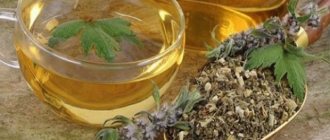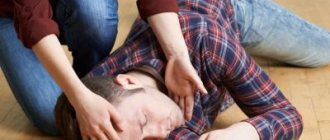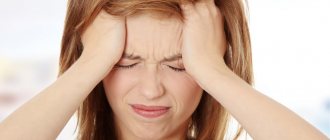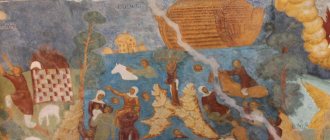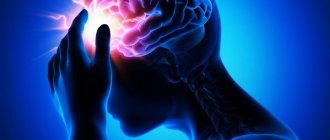Among diseases of the nervous system, epilepsy is considered the most unpleasant, as a person loses consciousness and has convulsions. In such a situation, it is advisable for relatives to be nearby, because the patient can choke on his tongue or hit himself painfully when falling to the floor. The disease manifests itself at any age, for example, in children due to hypoxia (oxygen starvation) or infection, and in older age due to head trauma. In people over 50, this problem arises due to pathologies of the cardiovascular system or degenerative diseases of the central nervous system such as Parkinson's disease.
It is difficult to predict how long an epileptic attack will last, but usually its duration varies from 5-10 seconds to 10 minutes. After it, the patient experiences a memory loss and is unable to remember recent events. After 1-2 hours, the epileptic’s condition stabilizes, and he does not understand what kind of seizure he is talking about. According to doctors, it is easier to prevent an epileptic attack, since it cannot be stopped and close people can only help the epileptic so that he does not injure himself.
What is "epilepsy"?
Epilepsy is a condition characterized by recurrent seizures caused by increased electrical activity in a particular area of the brain. If only one part of the brain remains involved in the process of abnormal electrical activity, the seizure is called partial, but if the electrical impulses spread to both hemispheres, the seizure is called generalized.
Epilepsy is a disease not only of humans, but also of other mammals: dogs, cats, mice
Partial seizures may not be accompanied by convulsions and loss of consciousness, occurring in the form of sensory hallucinations. Generalized seizures are most often accompanied by disturbances of consciousness and convulsions.
Absence seizures can be distinguished as a separate form of epileptic seizure. These are unusually short seizures (lasting tens of seconds) characterized by a sudden fall of the patient into a state of stupor: motor activity abruptly stops, the pupils do not move, speech stops, and there is no reaction to any external stimuli. Most often, absence seizures appear from the age of 5-6 years.
Possible consequences and complications
Lack of therapeutic therapy in the presence of the disease can lead to the development of complications:
- aspiration pneumonia - occurs when remnants of vomit, food or small objects enter the lungs during an attack;
- status epilepticus – constantly recurring seizures, when one seizure is superimposed on another and the patient’s life is threatened;
- mental disorders - depression, increased aggressiveness, isolation.
Epilepsy has more than 48 forms of manifestation. In different people, epileptic seizures occur in different ways - with or without loss of consciousness, with freezing of the eyes, twitching, convulsions or auditory hallucinations.
With the help of well-chosen treatment and constant use of medications, frequent episodes of attacks can be stopped and the patient’s quality of life can be significantly improved.
What causes epilepsy?
Despite the fact that there are 50 million people with epilepsy worldwide, in most cases the causes of its occurrence are not established. Indirect causes of epilepsy are considered:
- intrauterine hypoxia;
- trauma during childbirth;
- a brain tumor;
- meningitis or encephalitis;
- congenital brain abnormality;
- suffered a stroke.
Most often, epilepsy makes itself felt in childhood and old age. The number of seizures can reach 100 per month or occur once every six months/year.
Herbal remedies in the treatment of seizures
Traditional treatment for epilepsy is considered very effective if carried out with the approval of a specialist. Sometimes herbs can completely replace taking pills - in mild cases. Here are effective recipes:
- Mix equal amounts of celandine, dill, chamomile, St. John's wort, and lavender. Add the same parts of lemon balm, motherwort, nettle, and hops. Brew three tablespoons of the mixture per liter and leave overnight. Drink a glass four times a day for 90 days.
- Grind 100 g of Sophora japonica fruits, pour in 500 ml of vodka. Leave in the dark for 4 days. Drink a tablespoon in the morning and evening with water. Course - 2 months.
- In a similar way, you can prepare and take tincture of arnica flowers for epilepsy.
Orange leaves, dandelion flowers, rue herb are good for attacks - brew them in a tablespoon per glass of water, drink 100-150 ml three times a day.
Epilepsy attack - what to do?
If a person near you has an epileptic attack, first aid consists of the following measures:
- During a convulsive attack, a person is in a helpless state and needs outside help. The first thing to do is to ask the onlookers, who will probably gather around the victim, to move away.
- If the attack occurs in a busy place (at a crossing, roadway), carefully move the person to a safe place. To do this, grab him under your arms and, holding his head, move him from the dangerous area. Otherwise, the victim cannot be moved.
- Be sure to remember the time the seizure started. The duration of the attack is a criterion for the need to call an ambulance. So, if the seizure lasts more than 5 minutes, dial “103”.
- During an attack, try to fix the victim’s head between the legs, and place a cushion of clothing under it, this will help prevent injuries accompanying the attack. For the same purpose, loosen the collar and other tight clothing on the victim.
- If a person's mouth is slightly open during an attack, insert a corner of the cloth there, which will protect against biting the tongue or cheeks. If your teeth are clenched, do not try to unclench them, nor do you try to insert a spoon or other hard object between your teeth. This will only lead to injury.
- Epilepsy attacks are accompanied by copious amounts of saliva, which should be wiped off with a clean cloth or handkerchief. If there is excessive drooling, you can turn the victim's head to the side.
- You should not try to forcefully stop convulsive movements, as this will not relax the spasmed muscles, but will only cause injuries and damage to the victim.
- Be sure to check the time. If a seizure lasts more than 5 minutes, or after the first seizure a second one begins, call an ambulance immediately.
- After the seizure has stopped, turn the person on their side to prevent the tongue from sticking in. Check to see if his airway is clear.
- Help the victim recover from an attack. Calm the person down, do not allow him to make sudden movements. In some cases, the attack is accompanied by involuntary urination. Convince the person that you are ready to help him (including avoiding psychological discomfort).
Herbs for epileptic seizures
Doctors advise epileptics to drink herbal decoctions with a diuretic effect to get rid of excess fluid, and plants with a calming effect on the nervous system will also help. Herbal medicine and traditional methods of treatment are a salvation for many older people and thanks to them, attacks occur much less frequently.
According to epileptics, the drug Novo-Passit is good at preventing seizures. It is created from natural ingredients:
- Hops;
- Valerian;
- Melissa;
- Passion flowers;
- Hawthorn.
Separately, you can highlight an auxiliary component called guaifenesin. It serves to remove anxious feelings. You must take the drug at least 3 times a day.
Other plants, such as passionflower, can also calm the central nervous system. Preparations created on the basis of its shoots must be taken at least 3 times a day, 30 drops each. The duration of the course is usually not particularly limited, but after a month of taking it, it is recommended to take a break for 2-3 weeks, and then it can be repeated.
Many pharmacies sell special herbal medicines. Their effect is quite mild and seizures occur much less frequently after taking this drug. The collection includes the following herbs:
- Cyanosis;
- Elecampane;
- Kalina;
- Calamus;
- Melissa;
- Licorice;
- Plantain;
- Yarrow.
Each of the listed herbs provides its own unique effect, and their combination brings many benefits in the treatment of pathological processes in the central nervous system. To prepare it you need to take 1 tbsp. l. collection and pour it into a glass of boiling water, then close it with a lid and let it brew until it cools completely. You should consume 50-70 ml at a time 3 times a day. The duration of treatment is six months.
The calming effect of valerian has long been known and it is perfect for preventing epileptic seizures. To do this, you need to take the dry roots of this plant and grind them well. The resulting mixture should be poured into a container with plain water in a ratio of 1 tbsp. l. per 250 ml of liquid, and then the broth should be allowed to brew for 10 hours. The finished drink should be consumed 1 tbsp. l. at least 3 times a day. For children under 18 years of age, it is better to reduce the dose to 1 tsp. The duration of taking this drug is 2 months.
Motherwort will be no less useful in order to avoid an attack and it does this due to its sedative properties. To prepare, you need to take 1 tbsp. l. dried and ground plant and pour it into a half-liter container with boiling water. Then the broth should be allowed to brew for 2-3 hours. You can use the finished product 2 tbsp. l. before each meal for 2 months.
Maryin root (evasive peony) helps relieve symptoms of nervousness in epileptics and improve sleep. Preparing the decoction is quite simple and for this you need to take 1 tsp. ground and dried plant roots and pour 250 ml of boiling water over them. The container with the broth should be closed and allowed to brew for an hour. It is allowed to consume the finished product before meals, 1 tbsp. l, and the course duration is 30 days. Sometimes difficulties arise in getting this plant and in such a situation you can buy a ready-made tincture at the pharmacy.
Due to the fact that epileptics are prohibited from drinking alcohol, it will need to be diluted with water in a ratio of 30 drops to 1/3 glass of water (50-70 ml). You will also need to drink it, namely before meals for 30 days. If there is no way to buy a ready-made product, then you can make a tincture from decorative peony. To do this you need to pick 100 grams. leaves and petals, and then pour 250 ml of alcohol into them. This remedy will have to be infused for 10-14 days, preferably in a dark place. You can use the finished tincture in the same way as one purchased at a pharmacy.
Doctors also advise using anticonvulsants, for example, the rhizomes of Scutellaria Baikal. This remedy is very popular in Siberia, since epilepsy attacks actually do not occur due to it. The upper part of the plant is used for decoction during flowering. Anyone can prepare it, but to do this you need to pick 20 grams. Scutellaria shoots, and then they need to be poured into a glass of boiling water. In an hour, the product will be ready and you need to drink 50-70 ml before meals. If you don’t want or have the opportunity to cook, you can buy a pharmaceutical version in powder form and usually a single dose before meals is from 5 to 10 g.
You can reduce the frequency of seizures and, accordingly, epileptic seizures with the help of Chernobyl roots (artemisia vulgare). To prepare, you need to mix half a liter of beer and 30 g of crushed plant, and then the resulting mixture must be boiled for 5 minutes. You need to drink it before meals, 50 ml.
What to do after an epileptic attack?
After an epileptic seizure, the victim experiences weakness, lethargy, and confusion. Often he does not remember what happened to him, so your task is to calm him down and explain what happened.
In some cases, a person may ask you to help them take medications that they have with them. It is strictly prohibited to administer any medications to the victim yourself.
Ask the person if they have had epileptic seizures before. If this happens for the first time, call an ambulance. Otherwise, discuss the need for this step with the victim.
Quite often after an attack a person immediately falls asleep. Don't wake him up as he needs to rest. Stay close until he wakes up.
First aid for an epileptic attack in adults and children differs in that the child should definitely call an ambulance.
Situations in which you should call an ambulance:
- an epileptic attack occurred in a person for the first time;
- the duration of the attack was more than 5 minutes;
- after a seizure, a person remains unconscious for more than 10 minutes;
- an epileptic seizure occurred in a child or an elderly person;
- the attack occurred in a pregnant woman;
- During a seizure, a person was injured.
Drug treatment of epilepsy
With the help of medications, epileptic seizures can be controlled. To do this you should:
- Take medications strictly as prescribed by the doctor.
- Seek advice from a doctor if the patient wants to change the prescribed antiepileptic drug to a generic (analogue).
- Do not stop taking medications on your own.
- Notify your doctor about the disappearance or reappearance of depression, unusual mood swings, and changes in general health.
When the disease is quickly diagnosed, half of the patients live without seizures, taking one drug prescribed for the first time for the treatment of epilepsy.
Therapy begins with a small dose of an antiepileptic drug. It is recommended to carry out monotherapy (treatment with one drug). If seizures do not disappear and the patient’s condition does not stabilize, the dose is gradually increased until positive dynamics are achieved.
For partial seizures use:
- carbamazepine: Finlepsin (50 tablets, 260 rubles), Carbamazepine (50 tablets, 40 rubles), Zeptol, Timonil, Tegretol (table, 300-400 rubles), Karbasan, Actineural.
- valproates: Convulex (syrup 130 rub., drops 180 rub.), Convulex Retard (table. 300-600 rub.), Depakine Chrono (table. 30 pcs. 580 rub.), Enkorat-Chrono (table. 130 rub.), Valparin Retard (table. 30 pcs. 380 rubles, 100 pcs. 600-900 rubles).
- phenytoin: Difenin (price 50 rubles).
- Phenobarbital: Luminal
Carbamazepine and valproate are first-line drugs. Phenytoin and phenobarbital have many side effects and are rarely used.
The daily dose of carbamazepine is 600-1200 mg, valproate is 1000-2500 mg, which is taken in equal parts in 2-3 doses.
Prolonged preparations are convenient to use - retard forms, which are taken 1-2 times a day. These are Depakine Chrono, Tegretol - PC, Finlepsin Retard.
For generalized attacks, valproate and carbamazepine are prescribed. Idiopathic generalized epilepsy is treated with valproate. For absence seizures, ethosuximide is used. Carbamazepine and phenytoin are not effective for myoclonic seizures.
In recent years, new antiepileptic drugs have often been used - Lamotrigine and Tiagabine, which have shown their effectiveness in practice.
Discontinuation of treatment may be considered if there have been no seizures for five years, and is based on a gradual reduction in drug dosage until complete discontinuation.
Treatment of a patient with status epilepticus is carried out with the help of sibazone (Seduxen, Diazepam), which is administered slowly intravenously (2 ml of 10 mg of the drug is dissolved in 20 ml of 40% glucose). Repeated administration is possible after 10-15 minutes. If sibazone is ineffective, Hexenal, Phenytoin, sodium thiopental are used (1 g of the drug dissolved in saline is administered as a 1-5% solution). After administering 5-10 ml of the drug, pause for a minute to avoid respiratory depression and hemodynamics.
Inhalation anesthesia with nitrous oxide with oxygen (2: 1) is advisable to use when intravenous administration of drugs is ineffective and is prohibited for use in patients in a coma, with collapse and respiratory disorders.
What can cause seizures?
The examinations carried out showed that the occurrence of an exacerbation occurs from a surge of nerve cells located in the brain, which, with increased excitability, cause epileptic seizures.
This can happen for many reasons:
- Lack of sleep – a sick person needs more sleep. If there are problems associated with insomnia, then evening walks and taking sedatives: valerian, valocordin, peony tincture are recommended.
- Dietary restrictions - it is necessary to reduce fluid intake, because... it provokes a surge in the disease; refusal of salty foods, which subsequently causes the consumption of large amounts of drink. In such cases, fluid is retained in the body and causes swelling, including swelling of the brain tissue. This causes intracranial pressure to rise and another attack occurs.
- Overheating in the sun can cause another surge, so it is better not to risk it and not sunbathe.
- Visiting discos where there is bright light, music and loud sounds will also provoke an attack. Light reflections, car headlights, and flickering lights are also contraindicated.
- Drinking alcohol is strictly prohibited for sick people. For this reason, doctors advise taking herbal decoctions for treatment, and diluting alcohol tinctures with water.
An attack can occur from overexcitation, nervousness, overwork, or stress.
Methods for preventing epilepsy
Thinking about how to cure epilepsy is the task of the attending physicians, but the patient himself can take care of preventive measures. Prevention of epilepsy for a person who has already been diagnosed is to do everything possible at home to prevent recurrent attacks. To do this, it is necessary to ensure good ventilation of living quarters, healthy sleep and nutrition, moderate physical activity, proper organization of rest and work. You can drink shiksha tea or use antiepileptic herbal preparations to calm the nervous system
It is also important to eliminate possible psychotraumatic factors and other additional harmful factors that can provoke attacks. It is better to avoid large crowds of people, try to avoid any infectious diseases, completely eliminate alcohol and smoking
You should not be afraid to take antibiotics and other medications along with antiepileptic drugs, this is not dangerous, but any additional acute illness can provoke an epileptic attack.
Prevention of epilepsy from the perspective of health workers is to prevent perinatal injuries, neuroinfections and other factors that provoke the disease.
